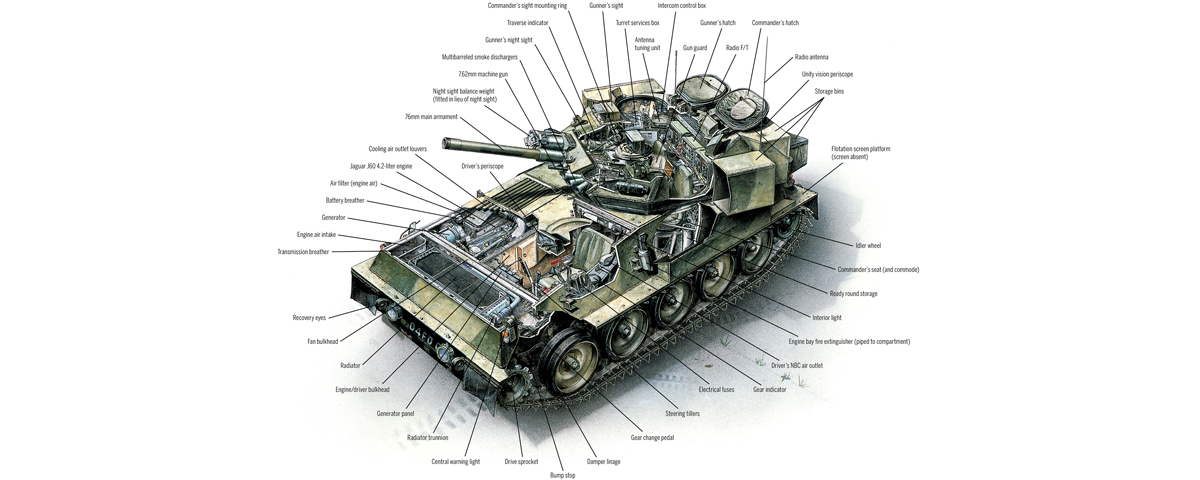Contracted by the British army in 1967 to develop a tracked reconnaissance combat vehicle, Alvis Ltd. (since absorbed by BAE Systems) delivered the first FV101 Scorpion prototype in January 1969. After rigorous testing in a range of climates, conditions and terrain, the army accepted the vehicle in May 1970 and fielded it in January 1972.
Originally powered by a Jaguar J60 4.2-liter gasoline engine (replaced by diesel engines in 1980), the Scorpion holds the Guinness world record for fastest production tank, with a max speed of 51 mph. Transported to combat zones by seagoing ship or in pairs by a C-130 Hercules, the Scorpion is capable of making an amphibious landing or water crossing using a flotation screen.
The Scorpion is armed with a 76mm cannon, but variants built atop its versatile chassis include the FV102 Striker antitank guided missile launcher, FV103 Spartan armored personnel carrier, FV104 Samaritan armored ambulance, FV105 Sultan command vehicle, FV106 Samson armored recovery vehicle and FV107 Scimitar recon vehicle with a 30mm L21A1 RARDEN cannon.
During the 1982 Falklands War four Scorpions, four Scimitars and a Samson of B Squadron, Blues and Royals, saw action on East Falkland Island, supporting 2nd Battalion, Parachute Regiment, on Wireless Ridge and the Scots Guards on Mount Tumbledown. Iran used Scorpion variants during its war with Iraq in the 1980s, and Britain used them again during the Gulf War in 1991 and in Bosnia-Herzegovina the following year. The United Kingdom retired its Scorpions in 1994, but it still uses Scimitars. A total of 3,362 Scorpions have served, or are still serving, in 21 countries.

Specifications
Crew: Three
Battle weight: 7.8 tons
Length: 14 feet 4.75 inches
Height: 6 feet 10.5 inches
Ground clearance: 14 inches
Engine: Jaguar J60 4.2-liter gasoline, dual overhead camshaft military version, six-cylinder
Power/weight ratio: 24.96 bhp/ton
Full capacity: 88 gallons
Ground pressure: 5 psi
Maximum speed: 51 mph
Acceleration: 0–30 mph in 16 seconds
Braking distance: 50 feet from 30 mph
Fuel consumption: 5 mpg at 30 mph
Range: More than 370 miles
Obstacle clearance: 20 inches
Trench crossing: 6.75 feet
Fording: 3 feet 6 inches (without flotation screen)
Water speed: 4 mph (tracks), 6 mph (propellers)
Gearbox: TN 15Z Crossdrive, semiautomatic seven-speed
Main armament: 76mm L23 gun
Elevation: 35 to -10 degrees
Range: 3.1 miles (indirect fire), 1.35 miles (direct fire)
Ammunition: 40 rounds (HE, HESH, HE&SH/practice, smoke canister and illuminating)
Secondary armament: Coaxial 7.62mm general-purpose machine gun (3,000 rounds)
Smoke dischargers: Two triple-barreled; also carries 18 smoke grenades
Radio sets: Types C42/B47, C13/B47, C13/42 or Clansman





